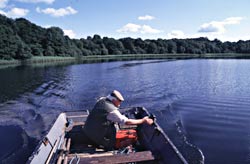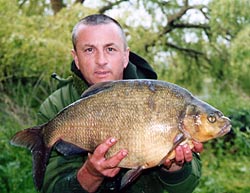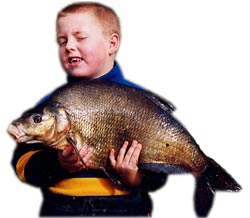| Part 1 – Location, the vital part of the equation Location – always, but always, the vital part of the equation, starting with the right pit! You can be fooled so easily. For instance, I know two waters that were stocked with just a couple of trout water bream that were well into double figures and the water than described as “holding bream to 14lb”. It’s the truth of course, but you have to ask yourself if the stock levels make angling for them a worthwhile prospect. It is a fact that some unscrupulous fishery owners will have you fishing for fish that are going to be very difficult to catch! You pays ya money and ya takes ya choice, as they say!
There are a lot of pits to choose from nowadays, ranging from the those dug in the 1940’s to some only a few years old. Some of the older ones are wonderful places to be; mature lakes in mature surroundings and stuffed with wildlife. Some of the newer ones and even sometimes the old ones are like a moonscape where even the slightest breeze can feel like a gale. I prefer the mature type, but if the fish are there and of a decent size then the newer ones will do! But whatever type, time is going to have to be spent in trying to pinpoint the areas the bream frequent. Talk to the anglers fishing the water – but beware! There are obvious short cuts of course. Talking to anglers fishing the water will produce information once they get to know you a little. Treat them and your surroundings with respect and most anglers are friendly enough and most enjoy the odd chat, especially if there are only a couple of you on the water. There’s always the exception to the rule of course, but I find most are friendly if approached correctly. Carp anglers can be a big help, (at least the knowledgeable ones can!) they may view you as a bit of a nutter and a friendly bit of banter may ensue, but on the whole it’s good fun, so try to make use of local knowledge. At the same time be careful, it’s surprising how big a 6lb bream can be to someone who doesn’t possess a set of scales but can still tell you of his 12lb 6oz bream! Walk the banks and pinpoint the rollers Spend as much time as possible walking the banks, especially at that special time of evening when lakes come to life. This is your best possible time to pinpoint ‘rollers’ and give yourself at least a chance of pinpointing bream. I have been on waters and been told that the bream never show, but I have yet to fish a decent bream water where I haven’t seen it happen! Admittedly, on some waters it has been a struggle and only the slightest glimpse has been seen but I have seen them nonetheless.
So, spend time looking for rollers and once pinpointed get to know the make-up of that part of the pit. It doesn’t matter if the pit is 10 or 210 acres we have find the fish. Explore the area, preferably from a boat Hopefully we’ve found bream so I’m now going to explore the area, preferably and, if allowed, from my dingy. Those of you reading this who think this is cheating should spend some time fishing a decent sized pit and then pass judgement! A boat allows much better exploration than anything used from the bank, and early in the year, before any algal blooms have taken hold, it is surprising how much you can see into some pits with a pair of polarised glasses. And a waterproofed glass bottomed box floating on the surface makes it even easier! Echo sounders are a boon, but ever since my old echo sounder gave up the ghost I have managed one way or another with the aid of a prodding pole; simply a length of 15mm plastic pipe with a small three pronged garden tool attached to the bottom, depth measurements (feet or metric, whichever you favour) are easily put on with electrical tape. With this I can drift along exploring the contours of the water and ‘feel’ gravel, silt or weed, a picture can be formed far quicker than from the bank.
What to look for What would I be looking for? Well, that all depends on the make-up of the pit in question. Earlier on I mentioned bars and plateaus but simply finding features doesn’t mean you will have found bream. Features on the lake bed don’t in themselves attract fish, but the features can produce feed pockets, clear gravel bars can hold some food pockets and sometimes that’s the reason they have been cleared. Feeding fish soon expose gravel from grubbing for food, but in my opinion the best areas of bars and plateaus is where the wind and/or undertow have caused pockets of ‘sweet’ silt to form (as apposed to the stinking type). Find these near to where you have spotted rollers and you could be onto something, for these silt pockets can hold a lot of food, they are the natural larders for bream and they love them, taking in large amounts of silt and passing it through their gills as they filter off the food it contains. These pockets, or beds, of silt can vary in size from tiny to immense but whatever their size they can be well worth investigating. Again, I would try to spot bream and then go in and explore the area from the boat or with the feature rod. I would look for silt (you can smell it on the lead!) or clearish gravel areas. Bream will feed on baited areas in silkweed but clear areas of gravel may mean that fish already feed there and are well worth a closer look. But as a general rule I would steer clear of thick, dense weed, or at least avoid fishing into it. Large channels in between it can be worth a look though – especially if it’s full of creepy-crawly infested silt! Homework is well worth it So get to know the layout of the pit; some are basically very deep with plateaus and ramps that need to be found, others are shallow with deeper trenches that also need to be found, watch for rollers and then explore that area for potential hotspots within……and when you are happy with what you have found give it a go! Don’t presume that bream are always 100yds out, even on big pits. I’m currently exploring a ‘new’ pit that is long and quite narrow. It is 40 acres with plateaus in the middle, the plateaus are very densely weeded and all the bream (actually only two as yet!) I have spotted have been at 30/40yds. All I’ve got to do now is catch the buggers! Part 2 of ‘Gravel Pit Bream’ next week. |
Welcome!Log into your account













